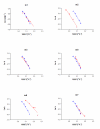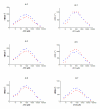The effect of engineered disulfide bonds on the stability of Drosophila melanogaster acetylcholinesterase
- PMID: 16686937
- PMCID: PMC1481510
- DOI: 10.1186/1471-2091-7-12
The effect of engineered disulfide bonds on the stability of Drosophila melanogaster acetylcholinesterase
Abstract
Background: Acetylcholinesterase is irreversibly inhibited by organophosphate and carbamate insecticides allowing its use in biosensors for detection of these insecticides. Drosophila acetylcholinesterase is the most sensitive enzyme known and has been improved by in vitro mutagenesis. However, its stability has to be improved for extensive utilization.
Results: To create a disulfide bond that could increase the stability of the Drosophila melanogaster acetylcholinesterase, we selected seven positions taking into account first the distance between Cbeta of two residues, in which newly introduced cysteines will form the new disulfide bond and second the conservation of the residues in the cholinesterase family. Most disulfide bonds tested did not increase and even decreased the stability of the protein. However, one engineered disulfide bridge, I327C/D375C showed significant stability increase toward denaturation by temperature (170 fold at 50 degrees C), urea, organic solvent and provided resistance to protease degradation. The new disulfide bridge links the N-terminal domain (first 356 aa) to the C-terminal domain. The quantities produced by this mutant were the same as in wild-type flies.
Conclusion: Addition of a disulfide bridge may either stabilize or unstabilize proteins. One bond out of the 7 tested provided significant stabilisation.
Figures



Similar articles
-
Improvement of Drosophila acetylcholinesterase stability by elimination of a free cysteine.BMC Biochem. 2002 Jul 30;3:21. doi: 10.1186/1471-2091-3-21. BMC Biochem. 2002. PMID: 12149129 Free PMC article.
-
Evidence for subdomain flexibility in Drosophila melanogaster acetylcholinesterase.Biochemistry. 2008 May 20;47(20):5599-607. doi: 10.1021/bi7025479. Epub 2008 Apr 26. Biochemistry. 2008. PMID: 18439026
-
"Designing out" disulfide bonds: thermodynamic properties of 30-51 cystine substitution mutants of bovine pancreatic trypsin inhibitor.Biochemistry. 1997 May 6;36(18):5323-35. doi: 10.1021/bi962423c. Biochemistry. 1997. PMID: 9154914
-
Drosophila acetylcholinesterase: mechanisms of resistance to organophosphates.Chem Biol Interact. 1993 Jun;87(1-3):233-8. doi: 10.1016/0009-2797(93)90047-3. Chem Biol Interact. 1993. PMID: 8343979 Review.
-
Disulfide bonds and protein folding.Biochemistry. 2000 Apr 18;39(15):4207-16. doi: 10.1021/bi992922o. Biochemistry. 2000. PMID: 10757967 Review.
Cited by
-
Creation of Cross-Linked Crystals With Intermolecular Disulfide Bonds Connecting Symmetry-Related Molecules Allows Retention of Tertiary Structure in Different Solvent Conditions.Front Mol Biosci. 2022 Jun 8;9:908394. doi: 10.3389/fmolb.2022.908394. eCollection 2022. Front Mol Biosci. 2022. PMID: 35755825 Free PMC article.
-
Independent of their localization in protein the hydrophobic amino acid residues have no effect on the molten globule state of apomyoglobin and the disulfide bond on the surface of apomyoglobin stabilizes this intermediate state.PLoS One. 2014 Jun 3;9(6):e98645. doi: 10.1371/journal.pone.0098645. eCollection 2014. PLoS One. 2014. PMID: 24892675 Free PMC article.
-
Engineering and introduction of de novo disulphide bridges in organophosphorus hydrolase enzyme for thermostability improvement.J Biosci. 2016 Dec;41(4):577-588. doi: 10.1007/s12038-016-9643-8. J Biosci. 2016. PMID: 27966481
-
Decoding the intricate network of molecular interactions of a hyperstable engineered biocatalyst.Chem Sci. 2020 Sep 11;11(41):11162-11178. doi: 10.1039/d0sc03367g. Chem Sci. 2020. PMID: 34094357 Free PMC article.
-
Introduction of a disulfide bond leads to stabilization and crystallization of a ricin immunogen.Proteins. 2011 Apr;79(4):1048-60. doi: 10.1002/prot.22933. Epub 2011 Jan 5. Proteins. 2011. PMID: 21387408 Free PMC article.
References
-
- Marty JL, Sode K, Karube I. Biosensor for detection of organophosphate and carbamate insecticides. Electroanalysis. 1992;4:801–803. doi: 10.1002/elan.1140040217. - DOI
-
- Bachmann TT, Leca B, Vilatte F, Marty JL, Fournier D, Schmid RD. Improved multianalyte detection of organophosphates and carbamates with disposable multielectrode biosensors using recombinant mutants of Drosophila acetylcholinesterase and artificial neural networks. Biosens Bioelectron. 2000;15:193–201. doi: 10.1016/S0956-5663(00)00055-5. - DOI - PubMed
-
- Payne CS, Saeed M, Wolfe AD. Ligand stabilization of cholinesterases. Biochim Biophys Acta. 1989;999:46–51. - PubMed
Publication types
MeSH terms
Substances
LinkOut - more resources
Full Text Sources
Other Literature Sources
Molecular Biology Databases

